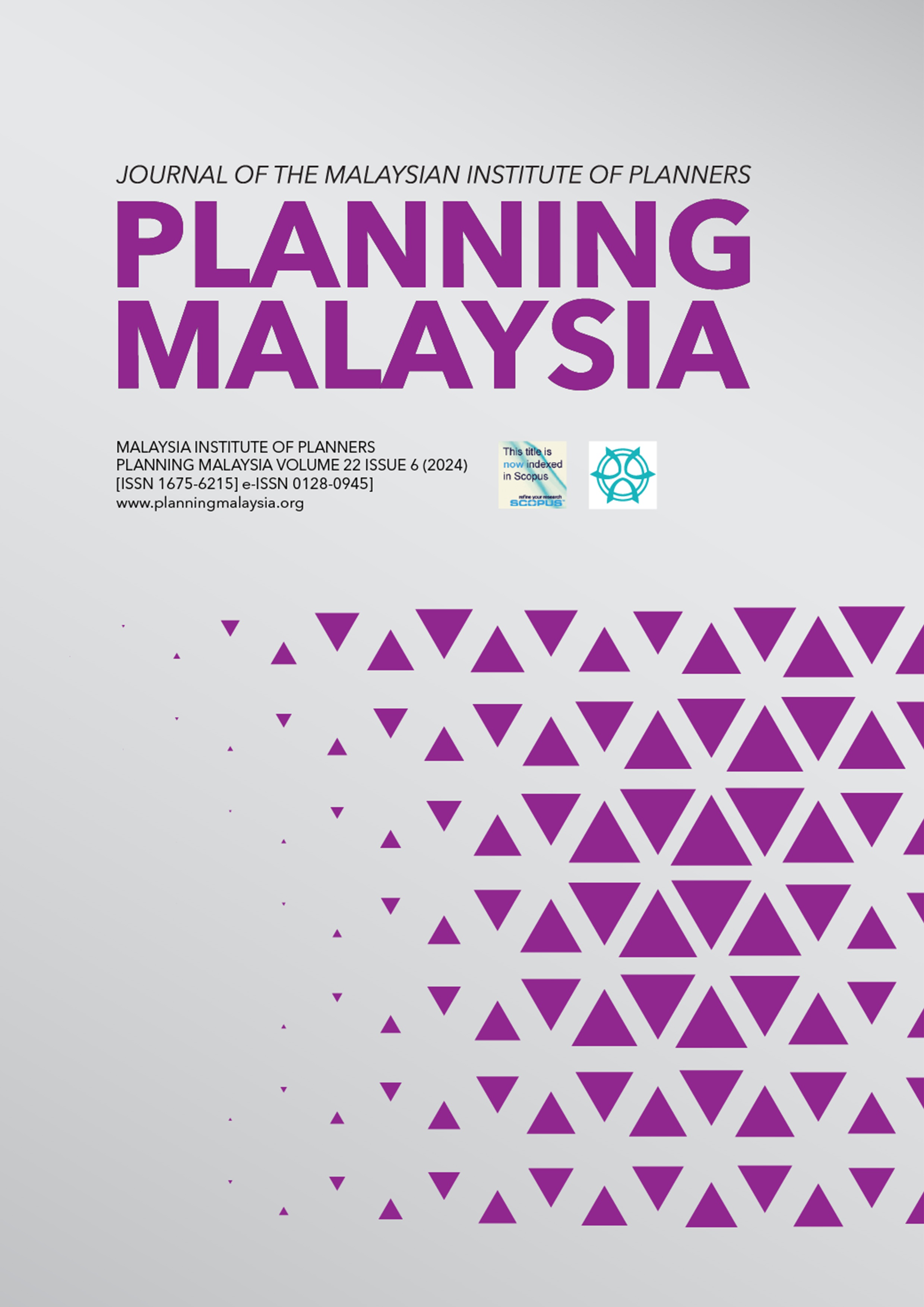THE INFLUENCE OF URBAN STREET FURNITURE TOWARDS HOMELESS IN KUALA LUMPUR, MALAYSIA
DOI:
https://doi.org/10.21837/pm.v22i34.1613Keywords:
exclusionary architecture, homeless, hostile, street furniture, urbanAbstract
Urban street furniture stands as a silent yet influential force in shaping the city's landscape and the lives of its residents. By studying urban street furniture in the context of homelessness, urban planners can work towards creating more inclusive cities for sustainable urban development. Thus, this qualitative research utilised three methods for data collection: literature review, semi-structured interviews, and participant observation. This comprehensive approach aimed to thoroughly understand the relationship between urban street furniture and the experiences of the homeless population in Kuala Lumpur, Malaysia. The findings of the observation in the case study, followed by the interviewed survey, revealed the multifaceted impact of urban street furniture on homeless individuals. Recognising and incorporating features such as comfortable seating, proper lighting, multi-functional planter boxes, access to clean water, and enhanced mobility through transportation hubs can all contribute to creating more supportive and inclusive urban environments for those experiencing homelessness.
Downloads
References
Abusaada, H., &Elshater, A. (2021). Effect of people on placemaking and affective atmospheres in city streets. Ain Shams Engineering Journal, 12(3), 3389–3403. https://doi.org/10.1016/j.asej.2021.04.019 DOI: https://doi.org/10.1016/j.asej.2021.04.019
Ahmad Yani, N. M., Zahari, N. Z., Abu Samah, N. F. H., & Mohamed Azahar, M. A. F. (2016). Factors Associated with Homelessness and its Medical Issues among Urban Malaysians: A Qualitative Research. DOI: https://doi.org/10.24191/jchs.v1i1.5853
Alamoush, S. J., Ja’afar, N. H., Mohd Husini, E., & Wan Norisma, W. I. (2018). Comfort Character of Landscape Features of Traditional Streets in Amman, Jordon. Planning Malaysia: Journal of the Malaysian Institute of Planners, 16(1), 63–74. DOI: https://doi.org/10.21837/pm.v16i5.411
Alowaimer, O. (2017). Causes, Effects and Issues of Homeless People. DOI: https://doi.org/10.4172/2167-0358.1000223
Amalina, N., Adib, M., Hussin, Z. H., & Ahmad, Y. (2018). How Effective are the Current Initiatives in Dealing with Homelessness in Malaysia? In Journal of Administrative Science Special Edition: ICOPS, JAS (Vol. 15). http:jas.uitm.edu.my
Amore, K., Howden-Chapman, P., & Baker, M. (2011). The ETHOS Definition and Classification of Homelessness: An Analysis. European Journal of Homelessness, 5(2). https://www.researchgate.net/publication/265799835
Badrudin, I. S., Al Sadat Zyed, Z., &Tedong, P. A. (2022). Preliminary Housing Continuum Model Framework for Young Households in Greater Kuala Lumpur. Planning Malaysia: Journal of the Malaysian Institute of Planners, 20(5), 79–94. DOI: https://doi.org/10.21837/pm.v20i24.1185
Carmona, M. (2021). Public Places Urban Spaces: The Dimensions of Urban Design (3rd Edition). https://matthew-carmona.com. DOI: https://doi.org/10.4324/9781315158457
Ismail, W. H. W., &Turiman, J. (2016). Physical Characteristics of Resting Places for the Homeless in Johor Bahru City Centre. Procedia - Social and Behavioral Sciences, 222, 907–914. https://doi.org/10.1016/j.sbspro.2016.05.228 DOI: https://doi.org/10.1016/j.sbspro.2016.05.228
Jabatan Perancangan Bandar dan Desa Negeri Selangor. (2017). Selangor State Structure Plan 2035. Warta Kerajaan Negeri Selangor, 70(301).
Kay Li, W. (2018). The Homeless in Malaysia: Issues and Policy Solutions. http://www.ubuntumalaysia.com/
Michael, E., & Teck, T. B. (2023). Understanding Homelessness in Malaysia: Effects and Solutions. International Journal of Advanced Natural Sciences and Engineering Researches, 3(3), 178–187. https://as-proceeding.com/index.php/ijanser
Mohamed, R., Awang, J., Sunawari Long, A., & Rahman, Z. A. (2018). NGO social interaction concept to deliver Kuala Lumpur homeless. International Journal of Civil Engineering and Technology, 9(6), 1456–1463.
Nur Syuhadah Hamdan, & Siti Sarah Herman. (2020). Homeless in Kuala Lumpur: A Way Out of The Street. Malaysia Architectural Journal, 2(1), 17–24.
Pable, J., McLane, Y., & Trujillo, L. (2022). Homelessness and the Built Environment: Designing for Unhoused Persons (1 Edition). New York: Routledge. http://lccn.loc.gov/2020051571 DOI: https://doi.org/10.4324/9780429279027-1
Pleace, N., &Hermans, K. (2020). Counting All Homelessness in Europe: The Case for Ending Separate Enumeration of ‘Hidden Homelessness’. European Journal of Homelessness, 14(3). http://www.legislation.gov.uk/ukpga/1977/48/section/1/enacted
Ramlan, M., Arshad, M., Zubaidah, A.-A., Kamal, M., &Arif, N. D. (2014). Street Begging in Kuala Lumpur. https://doi.org/10.7763/IPEDR DOI: https://doi.org/10.7763/ipedr
Rashid, S. A., Wahab, M. H., & Wan Rani, W. N. M. B. (2020). An analysis of safety perception in the street of Kuala Lumpur. In Journal of Critical Reviews (Vol. 7, Issue 5, pp. 52–55). Innovare Academics Sciences Pvt. Ltd. https://doi.org/10.31838/jcr.07.05.09 DOI: https://doi.org/10.31838/jcr.07.05.09
Reeve, K., & Batty, E. (2011). The Hidden Truth About Homelessness: Experiences of Single Homelessness in England. Crisis UK.
Schindler, S. (2015). Architectural exclusion: Discrimination and segregation through the physical design of the built environment. Yale Law Journal, 124(6), 1934–2024.
Syafiq, S. (2018). The homeless’ survival strategy in Kuala Lumpur city. Sains Humanika, 10(2), 19–29. www.sainshumanika.utm.my
Uta Dietrich. (2018). Homelessness in Kuala Lumpur. An Intractable Problem. https://thinkcity.com.my/wp/wp-content/uploads/2019/09/Homelessness-Report-Final-07-May-2018.pdf
Valado, M. T. (2006). Factors Influencing Homeless People’s Perception and Use of Urban Space. The University of Arizona.
Yeoh, S. G. (2017). The World Class City, the homeless and soup kitchens in Kuala Lumpur. Current Sociology, 65(4), 571–586. https://doi.org/10.1177/0011392117697464 DOI: https://doi.org/10.1177/0011392117697464
Young, A., & Petty, J. (2020). Homelessness and place. In The Routledge Handbook of Place (pp. 477–485). Taylor and Francis. https://doi.org/10.4324/9780429453267-42 DOI: https://doi.org/10.4324/9780429453267-42
Downloads
Published
How to Cite
Issue
Section
License

This work is licensed under a Creative Commons Attribution-NonCommercial-NoDerivatives 3.0 Unported License.
Copyright & Creative Commons Licence
eISSN: 0128-0945 © Year. The Authors. Published for Malaysia Institute of Planners. This is an open-access article under the CC BY-NC-ND license.
The authors hold the copyright without restrictions and also retain publishing rights without restrictions.


